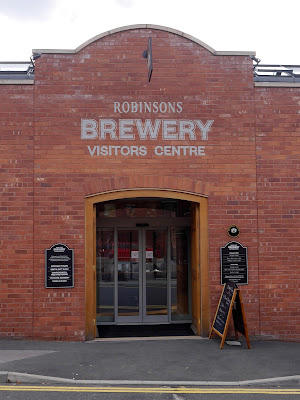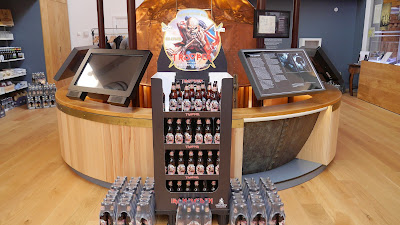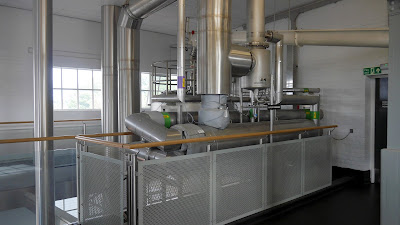I was down in Manchester to watch the England v Australia ODI at Old Trafford this weekend and decided that I really couldn't subject my Dad to another lengthy pub crawl as per our exploits in Durham last year. Instead I thought that a brewery tour would be a more sensible (and sedate) alternative and since Robinsons in Stockport had just opened their Visitor Centre earlier in the year this seemed like a good opportunity to see how a larger 'regional' brewery operates and possibly try a few of their newer beers.
View Robinsons in a larger map
Outward travel was as follows:-
Train: Manchester Picadilly to Stockport (every 10 minutes, Virgin Trains off-peak is cheaper)
The walk from Stockport train station to Robinsons Unicorn brewery, situated pretty well in the middle of Stockport town centre, took about 10 minutes. It's a fantastic red-bricked Victorian building which has a prominent position on the Stockport skyline.
The trade entrance is on Lower Hillgate...
...but the Visitor Centre entrance is on the complete opposite side on Apsley Street (there is a car park immediately opposite).
We checked in at the main desk and then took a bit of time to look around the large, bright, modern room housing a mixture of modern audio-visual displays and old fashioned brewery memorabilia. Pride of place in the centre of the room is one of the huge original Coppers, still gleaming but somewhat dented by (supposedly) the brewers throwing in lumps of sugar down the years.
However... in front of the Copper was a display of Iron Maiden's Trooper beer, brewed by Robinsons and an incredible commercial success story (currently their best selling beer). I can see why they would want to do this but it just seemed a bit too (I don't know) out-of-place perhaps (and it didn't help that I didn't really like the beer (at all) when I tried it in bottled format earlier in the year). Having said all that there's no doubt it's a striking artwork and makes for a great label and pump-clip.
In other parts of the room was a dray cart (no shire horses unfortunately) and...
...a map of Robinsons pubs (currently 360 of them) and most of Robinsons current range of beer.
There were also a few Rum & Port bottles on display with names such as Ye Olde Times, Bimbo & Old Ruby. It seems Robinsons imported and bottled these spirits quite a few years ago (I couldn't find out when).
By now the place was filling up with the attendees for the final tour of the day (including a group of 4 in full Iron Maiden attire, so you simply can't knock Robinsons' marketing savvy). Our tour guide Graham arrived (I remembered his name, probably a first for me) and warned us that we would have to clamber the 56 steel mesh steps up to the top of the building. The reason for this is the the brewery is (or at least was) gravity fed - brewing operations start at the very top of the building and are then distributed down through the various levels to the bottom floor. That means that the water is stored on the top level and this comes from a pair of boreholes into the Manchester Aquifer, a source of fairly soft water which is tested every day for mineral content and then 'Burtonised' as required. It was here that we saw the first of the new pieces of Steinecker brewing equipment that been installed in the brewery between 2010 & 2012 by German conglomerate Krones at a cost of approximately £5million (there was no British company which could provide the same service).
Graham explained that the Robinson family made a couple (probably a lot more than a couple) of key decisions about the new brewhouse. Firstly that the new brewing equipment would be installed in the same building as the current equipment (requiring a large build-up of stockpiled beer and also the removal of the main roof of the Unicorn Brewery during installation). Secondly that (when possible) some of the old brewing equipment would be left behind for, well, for people like us playing at beer tourists, and (of course) for celebrating their brewing history. Both decisions cost the Company a lot of extra money over & above what would have been necessary in comparison to a totally new build at an out-of-town Industrial Estate, but were deemed to be necessary as part of the company's local and historical responsibility, a really impressive stance. They weren't brewing today (Saturday is cleaning day, double drats!), but even during the week the wonderful old brewery aroma of sweet malt & citrusy hops isn't really present as it was in years gone by as everything is captured at the top of the building and the waste heat re-cycled in the Vapour Condenser. This has supposedly helped reduce energy consumption in the brewery by 30%.
Graham then started to describe the flow of the brewing process and first of all explained how & why malting happens, passing around various samples of malt to try. Most of this is British-grown malt but there was also Lager Malt & Munich Malt from the continent.
The new Variomill is used to both wet the malt and crush it and is a gleaming piece of functional equipment...
...whereas the original Seck Mill is a fantastic piece of old-style heavy engineering which probably needed ear defenders to be up-close to.
There were also hops to try, again mostly British but with some Perle & Saaz continental hops and lots of orangey citrus goodness from US Amarillo hops. Almost all the bittering hops are pellet based, it's only the aroma hops which are primarily whole flowers - it's purely a cost driven exercise with regards to the huge brewlength they operate with.
We then all traipsed down to next level where water is added to the malt to produce the sweet wort. This is where you actually start to see the size of the brewing operation - the brewlength can be up to 17,000 pints which by my reckoning equates to close to 60 barrels, and they can do this up to 4 times a day! Here there were lots more seriously huge shiny pieces of kit, the Mash Vessel (I remarked that it was obviously too modern to be called a Tun) and...
...the Lauter Tun (I retracted the previous smartarse comment in front of everyone, and then shut-up)...
...and the Cereal Cooker, used to cook wheat, rice, corn or other grains that might also be used in a specific beer.
Compare all this to the old wooden Mash Tun which used to be dug out by hand in sweltering conditions (the workers had their own beer allowance for this). Since the new Mash Vessel (and everything else) is cleaned automatically these guys now mostly work at the bottling plant in Bredbury.
The Control Room is on the same scale as the rest of the brewery but in complete reverse, it was tiny, with only 1 desk and 2 PCs (although I believe there is some additional monitoring performed by the German manufacturer).
The brewer sets out the hops required for the beer at the start of the brewing process and these are then realised in the Hop Preparation room. The first 3 'chutes' are used for the bittering hops (hop pellets), the final one is for the whole hops (which I think goes down to the Hopnick).
Again the new Copper is a shiny piece of kit...
...but the old Copper is really well, made out of copper.
Down a further level is the Hopnick (or Hopback), used to maximise aroma from whole hops and also when other adjuncts are used such as berries (for winter's Tom and Berry) or ginger (Ginger Tom). Robinsons' Hopnick was supposedly the largest in the world when it was first installed.
After going through a whirlpool (to filter & remove a lot of the protein based solids) and then the mother of all heat exchangers, the cool hoppy wort is sent to the Fermenting Vessels where yeast is added. There were a lot of these (I think I saw up to FV15) and they are all open (in comparison to the closed ones I saw at Thornbridge's Riverside Brewery). There were also a couple of partially closed vessels holding Fentiman's Ginger Beer.
Some of the patterns of krausen on the top of the fermenting beer were incredibly intricate and there was also the occasional massive belch of CO2, one of which almost knocked me off my feet. Robinsons use so much yeast that they share a portion of it with a number of the local microbreweries.
As far as I could see there aren't any new style Conditioning Tanks on-site so any conditioning and the adding of finings for cask beer, as well as further chilling, maturing & filtering for bottled & kegged beer, must be performed at the Bredbury plant, some 3 miles away. And that was it; after pretty close to an hour we all headed (in a fairly orderly stampede) to the bar of the Visitor Centre - all light wood, hand-pulls, shiny key fonts and masses of old & new bottles. Here I managed to take this pic of our friendly tour guide (Graham's laughing because one of the barstaff (not in shot) had just commented that it's the first time she had ever seen Graham without accompanying pint glass in hand).
The Visitor Centre is setup to provide beer (and food) for a good number of people and they have already hosted a large number of corporate events, beer launches and beer & food matchings (for example the Simon Rimmer beers). As per the brewery itself it's a mixture of bright new furnishings...
...but still with a nod to Robinsons' past (the use of the old conditioning tanks is great).
As part of the tour you get a choice of either a pint (or a bottle) of beer or three 1/3 pint tasters with most people opting for the three 1/3rds (I actually got 5 since my Dad only wanted 1). The Dizzy's Dark Side was new to me (and a pretty decent mild), and I tried the Trooper (twice) on cask, but still thought it was very mediocre (I wanted a lot more overall intensity in an ESB), but the best beer I had was the kegged Frederic's 175 - bumped up to 6.5% (from 4.3% on cask) with some dark fruit bitterness, a decent bitter finish, maybe a tad fizzy, but pretty good.
As always it was great to have a look around a working brewery, many thanks to Graham for the very informative tour. Even though the Unicorn Brewery is huge in size you can still feel the passion these people have for their beer, and the fact that the brewhouse redevelopment has stayed in the same building with no loss in jobs speaks volumes for the commitment of the Robinson family to the local area.
Return travel:-
Train: Stockport to Manchester Picadilly (every 10 minutes)





























Very interesting blog.thanks for sharing this blog and its very informative
ReplyDeleteStudent accommodation sheffield